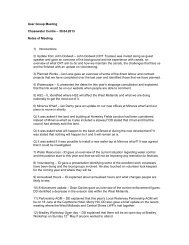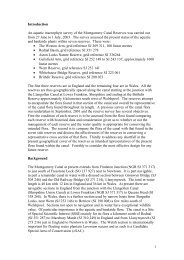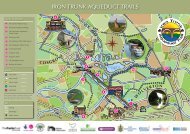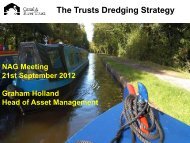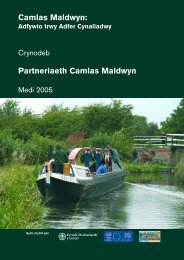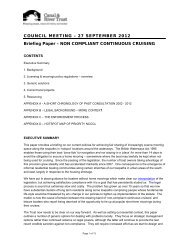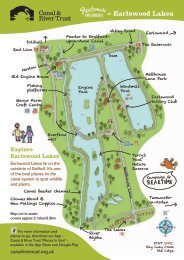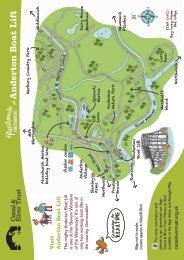Montgomery Canal Conservation Management Strategy (1.2MB PDF)
Montgomery Canal Conservation Management Strategy (1.2MB PDF)
Montgomery Canal Conservation Management Strategy (1.2MB PDF)
You also want an ePaper? Increase the reach of your titles
YUMPU automatically turns print PDFs into web optimized ePapers that Google loves.
Locally, the <strong>Montgomery</strong> <strong>Canal</strong> Partnership will adopt the following policies:<br />
J) Interpretative and education facilities and services will be provided to increase understanding of the canal<br />
environment and heritage, and encourage public participation in the canal’s future.<br />
K) Facilities will be developed to complement local provision by other organisations.<br />
L) On-site interpretative signage will be sited and designed to impart maximum information in an unobtrusive way.<br />
M) All general canal interpretative and educational materials, and all materials specific to Wales will be bi-lingual.<br />
6.6.5 Car Parking and Public Transport<br />
The Partnership seek to actively promote a sustainable restoration, and therefore wish to minimise the impact of visitors<br />
on the environment. There will therefore be policies that seek to encourage further exploration of the canal by means<br />
other than private cars.<br />
N) Car parking will be sited to encourage further exploration on foot, and will include cycle parking facilities.<br />
O) Location of new facilities will take into account public transport links where appropriate.<br />
P) As the canal popularity increases increased further public transport links will be developed and promoted.<br />
6.7 ECONOMIC AND RURAL REGENERATION<br />
The restoration can contribute to economic and rural regeneration via three mechanisms:<br />
• A temporary boost to local businesses through the implementation of the restoration work. Primarily, but not<br />
exclusively, this will be construction related.<br />
• A long-term post-restoration impact through higher visitor spend associated with greater canal-based activity, both by<br />
local people and in-bound tourists and visitors.<br />
• Through the role which the restoration can play as a catalyst for new commercial development.<br />
6.7.1 Restoration work<br />
How far the local economy benefits from spending during the construction phase will depend on the location of suppliers.<br />
Money does not always enter the local economy, or remain within it for long – the loss of money out of an area being<br />
referred to as leakage. Money spent with a local supplier will increase the spending power of that local supplier, with<br />
further knock on benefits. In addition, wages paid to people who live as well as work locally leads to more money being<br />
retained and re-spent in the local area. These effects are known as multipliers.<br />
Local suppliers should still be expected to conform to best practice sustainability and environmental standards.<br />
A) The Partnership recognises that good relationships with local suppliers, managed to high standards, can deliver a<br />
both a high quality and a good value service, therefore systems will be established that enable local firms to bid for<br />
supply and contracts throughout periods of major expenditure.<br />
This will reduce leakage, increase the multiplier effect, and thus maximise local economic benefits, and further<br />
strengthen community links<br />
B) Supplying companies will be monitored for environmental and sustainability criteria, and encouraged to adopt better<br />
practice (see Chapter 10, Monitoring)<br />
82



